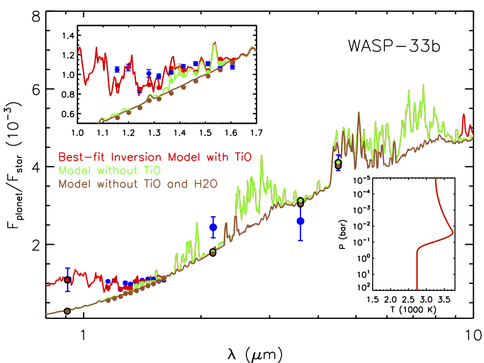2014 Annual Science Report
 NASA Goddard Space Flight Center
Reporting | SEP 2013 – DEC 2014
NASA Goddard Space Flight Center
Reporting | SEP 2013 – DEC 2014
Exploring the Structure and Composition of Massive Exoplanets
Project Summary
We have analyzed exoplanet transit and eclipse measurements with the Hubble Space Telescope (HST) and the Spitzer Space Telescope for a number of highly irradiated, Jupiter-mass planets, with a focus on confirming which planets exhibit water absorption or emission in transit and/or eclipse and measuring the characteristic brightness temperature at these wavelengths. Measurements of molecular absorption in the atmospheres of these planets offer the chance to explore several outstanding questions regarding the atmospheric structure and composition of hot Jupiters, including the possibility of bulk compositional variations between planets and the presence or absence of a stratospheric temperature inversion. We are also developing simulations of future observations with the James Webb Space Telescope, and we are in the process of designing a future balloon-borne telescope to conduct a large survey of hot exoplanet atmospheres.
Project Progress
In this reporting period, we have focused on analyzing WASP-33b, one of the hottest exoplanets known, during secondary eclipse. This massive hot planet provides the best opportunity to determine whether stratospheric temperature inversions exist in Jupiter-mass planets – a key factor in interpreting their spectra and determining their composition. We analyzed data for two secondary occultations with an updated methodology that allows us to correct for channel– or wavelength–dependent instrumental effects by utilizing the band-integrated time series and measurements of the drift of the spectra on the detector over time. We have developed a data reduction pipeline and analysis methodology that produces spectra with precision close to the theoretical noise floor for individual spectral bins. The final results strongly suggest the presence of water emission at 1.4 µm due to a thermal inversion, making WASP-33b the first planet with a spectroscopically confirmed inversion (Figure 1). A paper detailing our efforts and results has been submitted to the Astrophysical Journal (Haynes et al. 2015)
Additionally, in collaboration with Klaus Pontoppidan at the Space Telescope Science Institute (STScI), we are developing a set of simulation algorithms to leverage the current progress on the official JWST Exposure Time Calculator. The simulator will incorporate up-to-date information on each instrument, and will eventually be made public online.
We are also in the design, planning and proposal stages for a balloon-borne telescope to observe transiting exoplanets above the Earth’s atmosphere, called the Transiting Exoplanet Explorer Balloon (TEEBall). The platform will provide an excellent opportunity to conduct a large-scale survey of hot exoplanets during a long-duration balloon flight in the Southern Hemisphere. In collaboration with Terry Hurford at GSFC, we have designed and flown a proof-of-concept telescope called the Observatory for Planetary Investigations from the Stratosphere (OPIS), which launched from Fort Sumner New Mexico in October 2014. The observatory utilized a 21” primary mirror and optical camera to measure the pointing stability and image quality at float altitudes of approximately 105,000 ft, above 99.5% of the Earth’s atmosphere. TEEBall will be planned for a first launch in 2018.
-
PROJECT INVESTIGATORS:
-
PROJECT MEMBERS:
Avi Mandell
Project Investigator
Natasha Batalha
Collaborator
Drake Deming
Collaborator
Korey Haynes
Collaborator
Terry Hurford
Collaborator
Nikku Madhusudhan
Collaborator
Klaus Pontoppidan
Collaborator
-
RELATED OBJECTIVES:
Objective 1.1
Formation and evolution of habitable planets.
Objective 1.2
Indirect and direct astronomical observations of extrasolar habitable planets.
Objective 7.2
Biosignatures to be sought in nearby planetary systems
